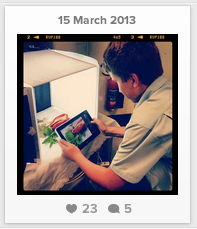Danielle Vandenberg recently posed this question on Twitter....
What's your key element for an effective #21stCentury classroom?
— Danielle Vandenberg (@DanielleVDB77) February 7, 2015
Immediately, relationships came to mind. Relationships set the tone of any effective learning space, whether it be an Education or Business environment. Yet, it is not the only key element. Relationships could be flourishing, however if resources were not made available can one learn, process and improve? How do we define resources and why? These branching questions led me to believe there is no one key element but key elements....and anyway, what exactly is 21st Century Learning???
I tend to grapple with the term 21st Century learning as if it is something to strive towards and achieve.
We are in the FIFTEENTH year of the 21st Century and there is still so much talk about moving towards 21st Century skills and learning.
These terms are bantered around frequently. I wonder how those outside the education sphere perceive such phrases and Eduspeak? Do various stakeholders hold a common view about "21st Century learning and skills"? Do they see any relevance in these conversations or the need for education to change? Are they content in the final product schooling produces? Does it meet their business and societal needs? As a society are we delivering? The paradigm shift is occurring. Is it being embraced by society? Do they know it is occurring? As a profession do we need to do more to help educate the wider public towards an understanding and appreciation of the paradigm shift?
I am also uncomfortable with the terms classroom and teacher. I prefer learning spaces, facilitator of learning or if need be, educator. Learning should not be confined to "classrooms", rooms for classes. Learning can and should happen anywhere, anytime. Embracing risks, innovation, connectivism, entrepreneurial studies, learning for whole community, continual learning journeys, blending school with the world of work, metacognition, workability skills, productivity, Social and Emotional learning are areas I like to focus on.
How do we successfully enable our youth, via the education space to navigate an uncertain and yet hopefully exciting and promising future?
This certainly demands a very different approach. Most educators would accept education has moved from strong knowledge acquisition to a skill based approach. A suite of competencies and a personalised environment where no one size fits all is the goal. Interpersonal skills, knowing HOW to learn, how to access information and what to do with knowledge takes centre stage for todays learner. This leads us to return to Danielle's question "What's your key element for an effective #21stCentury classroom?" What makes for an effective learning environment? The following elements spring to mind:
- supportive and skilled facilitator of learning
- safe learning environment (feeling open to learning opportunities)
- awareness and recognition of the importance of life long learning
- critical thinking skills
- communication skills (on and offline)
- digital safety and digital skills
- creativity skills
- flexibility
- collaboration
- productivity skills
- partnerships (family, business, community)
- computational thinking (problem solving, decomposition)
- adapting to change
- ability to play, explore and discover
- time set aside to just be
- access to technology
- sharing practice
- embracing real world context
Why act within silos of specialisation? Kudos to primary schools, PBL projects and secondary schools who often design learning, blending a variety of traditional KLAS (Key learning areas). Kudos to the students who drive their own educational agendas grasping responsibility for their own educational journey. Kudos to the educators that get out of their way! Kudos to the teachers who maintain an open growth mindset and endeavour to inspire, support and facilitate rather than indoctrinate.
There has been a need to re-image the learning space. The morphing is occurring.
Keeping the conversations flowing,
JJ
@7mrsjames
@ozftchat
@instaedglobal
#28daysofwriting #blogpost5 #bloggingchallenge























